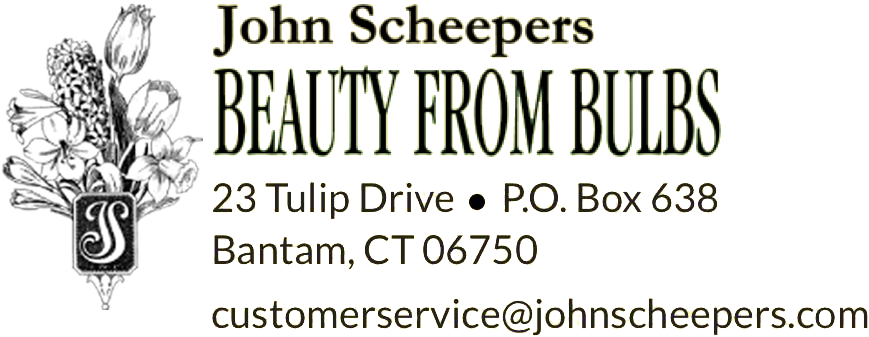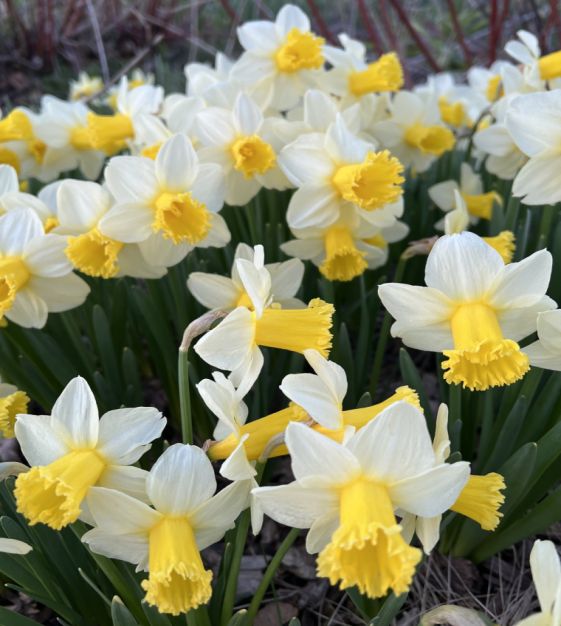-
- 20%-Off Website Specials
- New for 2024!
- Tulips
- Narcissi
- Allium
- Anemone blanda
- Brodiaea
- Camassia
- Chionodoxa
- Corydalis
- Crocus
- Eranthis
- Eremurus
- Erythronium
- Fritillaria
- Galanthus
- Geranium
- Gladiolus
- Hyacinths
- Hyacinthoides
- Ipheion uniflorum
- Dutch Iris
- Rock Garden Iris
- Ixiolirion
- Leucojum Aestivum
- Muscari
- Ornithogalum
- Oxalis
- Puschkinia
- Scilla
- Lilies
- Peonies
- Tender Bulbs
- Anemone Giants
- Tecolote Ranunculus
- Freesias
- Paperwhites
- Amaryllis
Narcissus Sugar Dipped
(6 W-Y) Registered by van Lierop in 2016, this Testcentrum Lisse hybrid has a delectable 3 1/4” flower that opens with a rounded, reflexed vivid yellow perianth that matures to greenish-white. Its long, funnel-shaped corona is vivid yellow, becoming a bit paler toward its intricately frilled, crystalline edge that sparkles with flecks of white here and there. Narcissus Class: Cyclamineus. Royal Horticultural Society Division 6. Bulb size: 12/14 cm. April. HZ: 3-8. Height: 16” to 18”.
Narcissi are The Art & Soul of Spring.
Narcissus Horticultural Tips Narcissus Forcing Tips
Narcissi are The Art & Soul of Spring.
Narcissus Horticultural Tips Narcissus Forcing Tips
- Information
Cyclamineus Narcissi
Cyclamineus Narcissi are best known for their reflexing, Cyclamen-like flower petals. The flower petals (perianth) are usually significantly reflexed and the flower is usually at an acute angle to the stem with a short neck. Among the earliest Narcissi to flower, Cyclamineus Narcissi are quite durable and are known to stand up to chilly spring nights. Because the flowers are smaller and yield one stem and flower per bulb, it's good to plant Cyclamineus Narcissi closer together than other sorts of Narcissi for fuller, more lush displays. They are great for rock gardens, sweeping drifts and clusters tucked into garden nooks and crannies. Cyclamineus Narcissi also force beautifully. They are also much loved for the fact that deer and rodents do not like to eat them!
All Narcissi tolerate a wide range of sunlight from full sun to semi-shade. Varieties with pink cups are shades of light salmon, apricot-pink, coral or soft old rose. They should be grown in areas of filtered sunlight where their delicately colored cups may be protected from direct sunlight that bleaches out their pinkness. Narcissi prefer well-draining soil, hate to get wet feet and love to be fed with a 4-10-6 or 5-10-5 granular organic flower bulb fertilizer three times a year. Allow the foliage to thrive and die back naturally without braiding or premature removal. DNII bulb size: 12/14 cm. Bloom time in horticultural zone 5: April. Plant 6" deep and 6" apart. Horticultural zones 3-8. Height: 6" to 16" depending on the variety. Narcissus classification: Royal Horticultural Society Division 6.
Narcissi are The Art & Soul of Spring.
Narcissus Horticultural Tips Narcissus Forcing Tips
Cyclamineus Narcissi are best known for their reflexing, Cyclamen-like flower petals. The flower petals (perianth) are usually significantly reflexed and the flower is usually at an acute angle to the stem with a short neck. Among the earliest Narcissi to flower, Cyclamineus Narcissi are quite durable and are known to stand up to chilly spring nights. Because the flowers are smaller and yield one stem and flower per bulb, it's good to plant Cyclamineus Narcissi closer together than other sorts of Narcissi for fuller, more lush displays. They are great for rock gardens, sweeping drifts and clusters tucked into garden nooks and crannies. Cyclamineus Narcissi also force beautifully. They are also much loved for the fact that deer and rodents do not like to eat them!
All Narcissi tolerate a wide range of sunlight from full sun to semi-shade. Varieties with pink cups are shades of light salmon, apricot-pink, coral or soft old rose. They should be grown in areas of filtered sunlight where their delicately colored cups may be protected from direct sunlight that bleaches out their pinkness. Narcissi prefer well-draining soil, hate to get wet feet and love to be fed with a 4-10-6 or 5-10-5 granular organic flower bulb fertilizer three times a year. Allow the foliage to thrive and die back naturally without braiding or premature removal. DNII bulb size: 12/14 cm. Bloom time in horticultural zone 5: April. Plant 6" deep and 6" apart. Horticultural zones 3-8. Height: 6" to 16" depending on the variety. Narcissus classification: Royal Horticultural Society Division 6.
Narcissi are The Art & Soul of Spring.
Narcissus Horticultural Tips Narcissus Forcing Tips
Cyclamineus Narcissi
Cyclamineus Narcissi are best known for their reflexing, Cyclamen-like flower petals. The flower petals (perianth) are usually significantly reflexed and the flower is usually at an acute angle to the stem with a short neck. Among the earliest Narcissi to flower, Cyclamineus Narcissi are quite durable and are known to stand up to chilly spring nights. Because the flowers are smaller and yield one stem and flower per bulb, it's good to plant Cyclamineus Narcissi closer together than other sorts of Narcissi for fuller, more lush displays. They are great for rock gardens, sweeping drifts and clusters tucked into garden nooks and crannies. Cyclamineus Narcissi also force beautifully. They are also much loved for the fact that deer and rodents do not like to eat them!
All Narcissi tolerate a wide range of sunlight from full sun to semi-shade. Varieties with pink cups are shades of light salmon, apricot-pink, coral or soft old rose. They should be grown in areas of filtered sunlight where their delicately colored cups may be protected from direct sunlight that bleaches out their pinkness. Narcissi prefer well-draining soil, hate to get wet feet and love to be fed with a 4-10-6 or 5-10-5 granular organic flower bulb fertilizer three times a year. Allow the foliage to thrive and die back naturally without braiding or premature removal. DNII bulb size: 12/14 cm. Bloom time in horticultural zone 5: April. Plant 6" deep and 6" apart. Horticultural zones 3-8. Height: 6" to 16" depending on the variety. Narcissus classification: Royal Horticultural Society Division 6.
Narcissi are The Art & Soul of Spring.
Narcissus Horticultural Tips Narcissus Forcing Tips
Cyclamineus Narcissi are best known for their reflexing, Cyclamen-like flower petals. The flower petals (perianth) are usually significantly reflexed and the flower is usually at an acute angle to the stem with a short neck. Among the earliest Narcissi to flower, Cyclamineus Narcissi are quite durable and are known to stand up to chilly spring nights. Because the flowers are smaller and yield one stem and flower per bulb, it's good to plant Cyclamineus Narcissi closer together than other sorts of Narcissi for fuller, more lush displays. They are great for rock gardens, sweeping drifts and clusters tucked into garden nooks and crannies. Cyclamineus Narcissi also force beautifully. They are also much loved for the fact that deer and rodents do not like to eat them!
All Narcissi tolerate a wide range of sunlight from full sun to semi-shade. Varieties with pink cups are shades of light salmon, apricot-pink, coral or soft old rose. They should be grown in areas of filtered sunlight where their delicately colored cups may be protected from direct sunlight that bleaches out their pinkness. Narcissi prefer well-draining soil, hate to get wet feet and love to be fed with a 4-10-6 or 5-10-5 granular organic flower bulb fertilizer three times a year. Allow the foliage to thrive and die back naturally without braiding or premature removal. DNII bulb size: 12/14 cm. Bloom time in horticultural zone 5: April. Plant 6" deep and 6" apart. Horticultural zones 3-8. Height: 6" to 16" depending on the variety. Narcissus classification: Royal Horticultural Society Division 6.
Narcissi are The Art & Soul of Spring.
Narcissus Horticultural Tips Narcissus Forcing Tips





